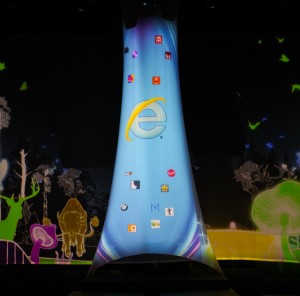Internet Explorer is a winner
 Microsoft competes the old-fashion way with its web browser -- innovation and marketing -- and that's a fairly recent trend. There are reasons companies advertise their products. Promotion raises awareness and, ideally, product adoption. Finally, after years of steady decline, Internet Explorer has sustained growth, at least for five months -- that's a quantifiable trend. In fact, IE was the only major browser to increase usage share in March. Additionally, Microsoft finally sees payback from its risky strategy of not making IE9 Windows XP compatible.
Microsoft competes the old-fashion way with its web browser -- innovation and marketing -- and that's a fairly recent trend. There are reasons companies advertise their products. Promotion raises awareness and, ideally, product adoption. Finally, after years of steady decline, Internet Explorer has sustained growth, at least for five months -- that's a quantifiable trend. In fact, IE was the only major browser to increase usage share in March. Additionally, Microsoft finally sees payback from its risky strategy of not making IE9 Windows XP compatible.
Net Applications releases new data the first of every month, but I waited a day to make absolutely sure this statement was no April Fools prank: "With a gain of .99 percent last month and a net gain of 1.2 percent global usage share over the last five months, Internet Explorer has stabilized and even reversed its usage share declines of the last few years".
Internet Explorer usage share rose to 53.83 percent in March. Yes, that's a long way from the 57.15 percent a year earlier or 60.35 percent in November 2010. IE usage share was over 90 percent in December 2004, when Firefox launched. How the mighty has fallen. But perhaps there is a second chance for Microsoft's browser, like Rocky Balboa's comeback in the third movie of the series.
What irony! Internet Explorer's recent rise started in November 2011, when I reported it was hemorrhaging usage share, following a long, steep decline. What changed? Microsoft set out on a specific strategy and stuck with it, by:
1. Making changes only as often as necessary. Google and Mozilla are now on fast-track development cycles, essentially six-weeks, with multiple versions in simultaneous development. That's fine for revving new innovations but terrible for business adoption. Enterprises, particularly, look for stability not change. Sure IE9 offers some dramatic security and plug-in changes from its predecessor, but over a manageable time period. In April 2011 I asked: "Is web browser development moving too fast?" For many businesses, yes.
In August 2011, Google started killing off support for old browsers, yet not that old. Venkat Panchapakesan, Google vice president of engineering, explains in a blog post a few months earlier: "Each time a new version is released, we'll begin supporting the update and stop supporting the third-oldest version." This approach makes Chrome obsolete about every 12 weeks, which isn't enough time for most businesses to qualify a browser.
Microsoft wisely chooses to develop at a pace more in step with its core customer base of businesses. Developers see rapid iteration on the beta front, but Microsoft saves big changes for major releases.
2. More soundly adopting web stands. After years of pushing proprietary stuff, Microsoft is a leader adopting and advocating accepted and emerging web standards, like HTML5. The approach has many benefits, with positive perceptions among the most important.
3. Steadily promoting new benefits and upping the advertising ante. Microsoft promotes the hell out of Internet Explorer across the web and on TV. I'm a big fan of the recent "A More Beautiful Web" commercial, which is lively and contemporary. Microsoft is slowly, and successfully, rebuilding IE's brand image.
4. Leaving Windows XP behind. Google and Mozilla browsers support XP (although that ends soon for Firefox), which accounted for 85 percent of the Windows install base when IE9 released in 2009. I questioned the soundness of the strategy in several blog posts over the last 18 months. But the approach appears to be working for Microsoft, and surely somebodies inside the company fiercely debated the strategy as Chrome usage share dramatically rose during the same time period. As Windows 7 adoption increases, so does IE9 adoption.
Still, IE is in a pitched battle with Chrome. That's right, not Firefox! By browser version, IE9 is just barely ahead of Chrome for second place -- 15.17 percent usage share to 14.73 percent, respectively. IE8 leads with 25.4 percent usage share. Frankly, Chrome could lead if Google released new versions less frequently.
Back to the broad strokes, Firefox usage share fell to 20.55 percent in March from 20.92 percent the previous month. Chrome dropped to 18.57 percent from 18.90 percent. Safari: 5.07 percent from 5.24 percent. Opera: 1.62 percent from 1.71 percent.
These declines reverse gains for Firefox and Safari. What really changed in March for competitors? Microsoft started the new IE marketing campaign.
My question to you: Are Internet Explorer usage gains sustainable?